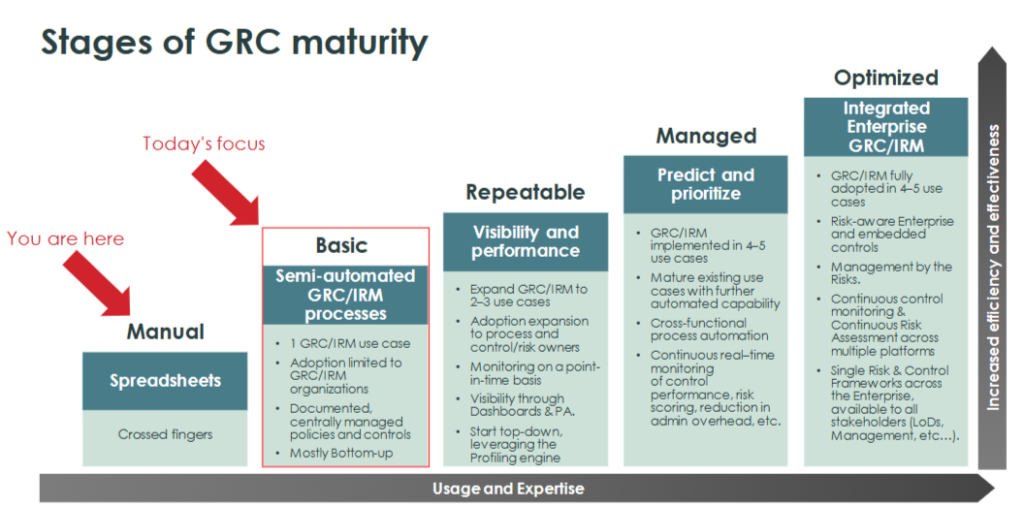5-Step Policy-Compliance Risk Management
5-Step Policy-Compliance Risk Management Implementation Tips: The successful implementation of ServiceNow Policy, Compliance, and Risk Management hinges on a meticulous and structured approach. This entails a series of critical steps designed to fortify governance, achieve regulatory compliance, and fortify risk management within the organization.
ServiceNow Getting Started 5-Step Policy-Compliance Risk Management
ServiceNow Stages of GRC maturity, where your first implementation is setting the foundations for Level 2 maturity. This involves establishing a sound Governance Risk and Compliance method with Integrated Risk Management Use Case to provide data driven decision making that replaces the manual and missed elements of Policy, Governance, and effective Risk Management. By centralizing documentation, policies and controls the manual spreadsheet and email campaigns are replaced with improved visibility and reporting that forms the foundation for repeatable managed process.
With ServiceNow GRC Maturity it is important to invest in the proper basic foundations of ServiceNow before going into “SOX” Controls, so there is familiarity with how to get the most out of ServiceNow. It can be a lot more difficult to back into the custom implementation of parts of GRC, to deliver SOX without the basics, as it will likely leave a longer period of time in manual efforts to manage SOX Compliance.

5-Step Policy-Compliance Risk Management
Step 1: Pre-implementation: Identify Teams, Business Objectives and Scope
In order to successfully implement ServiceNow Policy, Compliance, and Risk Management, it’s imperative to first establish clear objectives. This involves setting precise goals such as achieving regulatory compliance, reducing risks, and enhancing overall governance within the organization.
Furthermore, defining the scope is equally critical. This entails identifying specific areas or processes that will fall under the purview of this implementation. This could encompass tasks like policy creation and management, conducting compliance assessments, and formulating strategies for risk identification and mitigation.
Step 2: Preparation: Identify Use Cases Processes and Workflows to define requirements for Configuring and Customizing the Platform
To align the ServiceNow platform with the organization’s unique requirements, a comprehensive configuration is necessary. This encompasses creating relevant fields, forms, workflows, and user roles to ensure seamless operation.
Additionally, the development of policies within the system is a pivotal aspect. This involves establishing a structured framework that outlines various policies and procedures. It’s essential to define policy categories, templates, and approval workflows for efficient management.
Establishing the compliance framework is another crucial facet at this stage. This involves identifying pertinent regulations, standards, and industry best practices that the organization must adhere to.
Step 3: Document the Current State to align steps for Migrating Data and Ensuring Integration
Smooth transition of existing policies, compliance documentation, and risk assessments into the ServiceNow platform is pivotal. Ensuring the integrity of data during this migration process is of utmost importance.
Integration of ServiceNow with other relevant systems, including IT Service Management (ITSM), Governance, Risk, and Compliance (GRC) tools, and third-party compliance databases, is essential. This integration guarantees a seamless flow of data and maintains consistency across all platforms.
Step 4: Select your Implementation Approach and SMEs for implemented solution and Providing Training and Encouraging Adoption
Comprehensive training is key for users, administrators, and compliance teams to effectively utilize the ServiceNow platform. This training covers various aspects including policy management, conducting compliance assessments, and identifying risks.
Fostering user adoption is equally crucial. This involves actively encouraging and incentivizing users to engage with the platform. Emphasizing the benefits of streamlined policy management, precise compliance tracking, and effective risk mitigation is essential.
Step 5: Train the teams on 5-Step Policy-Compliance Risk Management Continuous Monitoring and Enhancements
Regular monitoring of compliance status, risk assessments, and policy adherence is paramount. ServiceNow’s reporting and analytics capabilities play a pivotal role in this aspect. Establishing alerts for critical issues or instances of non-compliance ensures timely intervention.
Build a GRC roadmap: Create a GRC roadmap that scales with your business, reduces compliance costs and resource requirements, improves operational efficiency, provides continuous insights, monitoring, and so much more.
Gathering feedback from users and stakeholders is crucial for identifying areas that require improvement. This feedback loop is vital for refining and optimizing the system. It ensures that the implementation remains aligned with evolving compliance requirements and the organization’s overall needs.
Build toward continuous monitoring: Build toward continuous monitoring so that you can identify control deficiencies when they happen and immediately begin remediation 3.
5-Step Policy-Compliance Risk Management Continuous Monitoring and Enhancements
In conclusion, by diligently following these five steps, organizations can effectively implement ServiceNow Policy, Compliance, and Risk Management. This implementation empowers the organization with better governance, adherence to regulations, and proactive risk mitigation. It’s important to remember that ongoing maintenance and periodic reviews are essential to ensure continued effectiveness and alignment with organizational objectives.
Resources
- Getting Ahead of Global Regulations
- Governance, Risk, and Compliance (GRC)
- GRC for SOX Compliance – Reduced Burden
- GRC Industry Reference Matrix
- ServiceNow Communities
- Slides for Getting Started
- ServiceNow IRM SOX FAQs
- SOX Control-Management and Attestation

-
Getting Started
- AI: ServiceNow Virtual-Agent Chatbot
- BMC Remedy ITSM Reference
- Burp Suite Professional & Web Security Process
- COE for Human Resources
- Conduct A Windows-Security Scan
- Employee Journey Management ServiceNow
- Getting Started: Engagement Manager
- Introduction to Knowledge Management
- Knowledge Categorization "Find-ability"
- One-IT: Effective Ticket Handling
- Productivity Tips for Knowledge-Users
- Productivity: Service Operations Workspace
- Quick Start Guide
- Service Catalog Order Guides
- Your Next Steps
-
- Advanced Program Management
- AI: ServiceNow Virtual-Agent Chatbot
- Artificial Intelligence A-Z Glossary
- Business Process Optimization Reviews
- Category Hierarchy and Tabs Layout
- Employee Journey Management ServiceNow
- GE Change Acceleration Process
- GRC Managed Risk
- Overview: Employee Center Pro
- Productivity: Service Operations Workspace
- Proper Ticket Handling Imperative
- Public Sector Digital Services
- RIDAC: Strategic Portfolio Management
- SOX Control-Management and Attestation
-
- Articles coming soon
-
FAQs
- Best of ServiceNow Vancouver
- Chat GPT FAQS
- DevOps & Change Velocity
- Enhancing End-User Service Experience
- FAQs: Governance Risk Compliance
- How-To Import ServiceNow Stories 🚀
- Knowledge Categorization "Find-ability"
- Role of CMDB-Management Service-Owner
- Service Catalog Process FAQs
- ServiceNow IRM SOX FAQs
- Strategic Portfolio Management FAQs
- Ticket Handling Infographic FAQs
- Understanding Clop Ransomware Mitigation
- Vulnerability Response Workspace Module
- Washington ESC or Knowledge Portal?
-
- AI & GRC Defense Against Security-Data Breach
- AI and Improved Knowledgebase-Search
- AI Revolutionizes Service Management
- AutomatePro AutoTest Custom-Testing
- AutomatePro AutoTest: Getting Started
- Best of ServiceNow Vancouver
- CMDB Health Dashboard
- Comparing ServiceNow-Strategic-PM to Microsoft-PM
- Demystifying Taxonomy Categorization
- DevOps & Change Velocity
- Efficient Workday to ServiceNow Integration
- Email-to-Incident is Costly Inefficiency
- Enhancing End-User Service Experience
- Financial Services Operations
- Gamifying ITSM Excellence
- GRC Industry Reference Matrix
- Introducing Security Incident Response
- Role of CMDB-Management Service-Owner
- Service Catalog Process FAQs
- ServiceNow Executive Reporting Approaches
- ServiceNow Virtual Agent Chatbot
- SPM Gantt Chart Presentation
- Strategic Portfolio Management FAQs
- Vulnerability Response Test Plan
- Vulnerability Response Workspace Module
- Washington ESC or Knowledge Portal?
- Show Remaining Articles11 Collapse Articles
-
Glossary Reference
-
Blog
- 2021: VP Harris Inauguration Elevates Diversity and Executive Leadership
- 5-Star ITSM Solutions
- 5-Step Policy-Compliance Risk Management
- AI & GRC Defense Against Security-Data Breach
- AI Revolutionizes Service Management
- AI: Knowledge Centered Support
- ChatGPT Ethics and FTC
- CMDB Corporate Governance for Publicly Held Companies
- Community Crisis Resource Reference List
- Covid Cyber Employment Fraud: $Millions in Job Fraud, $Billions in Unemployment Fraud. Recruiters and Jobseekers Paradigm shift
- Does Post Covid Demand, "Evolve or Fold" Data Strategy?
- Financial Services Operations
- Freshwork's Multichannel vision for FreshService (ITSM)
- Gamifying ITSM Excellence
- GRC Industry Reference Matrix
- Imperative: Governance Risk Compliance
- Jobs n Career Success: Employment News
- Microsoft Teams Tripping Transcription Tenancy.
- Predictive Intelligent Situational Awareness
- Remedy to ServiceNow Migration
- Review and Approve Knowledge
- ROI: Demand AI Service Management
- Top Trends in Project Management
- Uber's Call Center Security Social Engineering Massive System Breach
- Vulnerability Remediation RACI
- Walk Up Experience- Design-To-Deliver
- World Talent Economy Forum on Global Competitiveness
- Show Remaining Articles12 Collapse Articles
-
Healthcare
-
Workday
-
Network Connectivity Solutions
-
Business Process Methodologies

